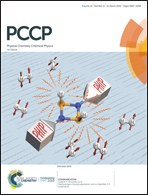Uncommon first universality of conductivity in superprotonic (NH4)3H(SeO4)2 single crystals
Abstract
The proton conducting crystal (NH4)3H(SeO4)2 is examined to check whether the first universality of conductivity spectra is sensitive to subtle changes in the crystal structure and proton dynamics caused by external pressure. The ac conductivity was measured along the trigonal c axis by means of impedance spectroscopy, in the frequency range from 100 Hz to 1 MHz, at temperatures 250 K < T < 330 K and pressures 0.1 < p < 380 MPa. The ac conductivity characteristics were analyzed using the Summerfield scaling procedure. In the temperature range of the experiment the master curve is strongly disturbed by the structural phase transition at Tc1 = 273 K but the scaled spectra superimpose within the temperature range of each individual phase (below and above Tc1). The effect of pressure on the scaled conductivity spectra considered separately for each of the studied phases is similar to that caused by temperature. This means that both stimuli give rise to an acceleration of the dynamics of protons and consequently to an increase in conductivity. The evolution of the scaled conductivity spectra with pressure close to the phase boundary between the triclinic, ferroelastic phase III (P![[1 with combining macron]](https://www.rsc.org/images/entities/char_0031_0304.gif) ) and the trigonal, superionic phase II (R
) and the trigonal, superionic phase II (R![[3 with combining macron]](https://www.rsc.org/images/entities/char_0033_0304.gif) ) points to the mixing of phase III with inclusions of phase II.
) points to the mixing of phase III with inclusions of phase II.



 Please wait while we load your content...
Please wait while we load your content...